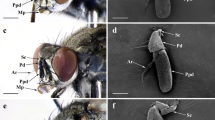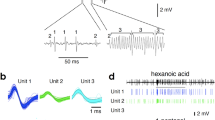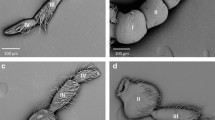Abstract
THERE exist only two previous descriptions of feeding behaviour in hermit crabs, namely, those of Thompson, who described the feeding of Eupagurus longicarpus Say., and of Orton on E. bernhardus (L.). Orton1 says that both species feed by scooping up debris directly with either the third maxillipeds or with the small chela. The material is brushed between the third maxillipeds, and the rejected portion falls to the ground. The antennæ and the walking legs play no part in the feeding of these animals.
This is a preview of subscription content, access via your institution
Access options
Subscribe to this journal
Receive 51 print issues and online access
$199.00 per year
only $3.90 per issue
Buy this article
- Purchase on Springer Link
- Instant access to full article PDF
Prices may be subject to local taxes which are calculated during checkout
Similar content being viewed by others
References
Orton, J. H., J. Mar. Biol. Assoc. U.K., 14, 909 (1927).
Nicol, E. A. T., J. Mar. Biol. Assoc. U.K., 18, 87 (1932).
Gauld, D. T., Proc. Zool. Soc. Lond., 132, 31 (1959).
MacGinitie, G. E., and MacGinitie, N., Natural History of Marine Animals (McGraw-Hill Book Co., Inc., New York, 1945).
Author information
Authors and Affiliations
Rights and permissions
About this article
Cite this article
BOLTT, R. Antennary Feeding of the Hermit Crab Diogenes brevirostris Stimpson. Nature 192, 1099–1100 (1961). https://doi.org/10.1038/1921099a0
Issue Date:
DOI: https://doi.org/10.1038/1921099a0
This article is cited by
-
Versatile hermit crabs harness multiple-source energy from coastal mudflats: implications for fish production
Aquatic Ecology (2015)
-
Multiple feeding techniques in the sessile hermit crab, Discorsopagurus schmitti, inhabiting polychaete tubes
Oecologia (1994)
-
Functional organisation of mouth parts, and filter feeding, inClibanarius longitarsus (Crustacea: Anomura)
Marine Biology (1991)
-
“Glandular pockets” of the integument and feeding mechanism inPagurus bernhardus (Crustacea: Anomura)
Marine Biology (1988)
-
Functional morphology of the mouthparts and associated structures of Pagurus rubricatus (Crustacea: Decapoda: Anomura) with special reference to feeding and grooming
Zoomorphology (1982)
Comments
By submitting a comment you agree to abide by our Terms and Community Guidelines. If you find something abusive or that does not comply with our terms or guidelines please flag it as inappropriate.



